George Arliss (1868 - 1946) was the first British actor to win an Academy Award. He was also an author, a playwright, and a Hollywood film maker with an unusual amount of creative control.
![George Arliss]()
Vintage postcard.
![George Arliss]()
British postcard in the Picturegoer series, no. 473.
![George Arliss]()
British postcard in the 'Famous Film Stars' series by Valentine, no. 7123G.
The Devil
George Arliss was born George Augustus Andrews in London, England, in 1868. He began his stage career in 1887 in the British provinces. By 1900, he was playing London's West End in supporting roles. He embarked for a tour of America in 1901 in Mrs. Patrick Campbell's troupe. Intending to remain in the USA only for the length of the tour, he stayed for twenty years eventually becoming a star on Broadway in 1908 with the satiric drama The Devil, by Ferenc Molnar. Producer George Tyler commissioned a play specifically tailored for Arliss in 1911 and the actor toured in Disraeli for five years, eventually becoming closely identified with the 19th century British prime minister. He began his film career with The Devil (1921, James Young), followed by Disraeli (1921, Henry Kolker), and four other silent films. Today, only The Devil and The Green Goddess (1923, Sidney Olcott), based on William Archer’s stage play, are known to have survived. He remade Disraeli (1929, Alfred E. Green) in sound and won the Academy Award for Best Actor. At 61, he converted successfully from a star of the legitimate theater, then of silent films, and finally into the talkies.
![George Arliss]()
Vintage postcard. Photo: publicity still for Disraeli.
![George Arliss]()
Polish postcard by De Reszke Minors Cigarettes. Photo: still from The House of Rothschild (1934, Alfred L. Werker).
Creative Control
George Arliss made ten sound films exclusively for Warner Bros. under a contract that gave the star an unusual amount of creative control over his films. Curiously, his casting of actors and rewriting of scripts were privileges granted him by the studio that are not even mentioned in his contract. After his first three films, Arliss approved an undistinguished director, John Adolfi, to direct each of his films from that point on. Adolfi soon found himself regarded as a successful director of the critically and financially acclaimed Arliss films. Arliss preferred to use the same reliable actors from film to film such as Ivan Simpson and Charles Evans. Yet he had an eye for discovering newcomers like James Cagney, Randolph Scott, and Dick Powell. The Man Who Played God (1932, John G. Adolfi) was Bette Davis' first leading role. Until the end of Davis' life, she would credit Arliss for personally insisting upon her as his leading lady and giving her a chance to show her mettle. The two also co-starred in The Working Man (1933, John G. Adolfi).
![George Arliss]()
British card. Photo: 20th Century. Publicity still for The Last Gentleman (1934, Sidney Lanfield).
![George Arliss]()
British postcard in the Picturegoer Series, London, no. 473a. Photo: Warner.
![George Arliss]()
British postcard in the Picturegoer Series, London, no. 473b. Photo: Gainsborough.
A Stolen Star
Despite his extensive involvement in the planning and production of his films, George Arliss claimed credit only for acting. Working closely with Warners production chief, Darryl Zanuck, Arliss left the studio when Zanuck resigned in April 1933. Zanuck quickly signed him to make new films at Zanuck's fledgling studio, 20th Century Pictures, prompting Warners to bitterly complain to the Motion Picture Academy of Arts and Sciences that Zanuck had ‘stolen’ their star. Arliss is remembered primarily for his witty series of historical biographies such as Alexander Hamilton (1931, John G. Adolfi), Voltaire (1933, John G. Adolfi), The House of Rothschild (1934, Alfred L. Werker) and Cardinal Richelieu (1935, Rowland V. Lee). However, he had a second string to his bow, domestic comedies such as The Millionaire (1931, John G. Adolfi), A Successful Calamity (1932, John G. Adolfi) and The Last Gentleman (1934, Sidney Lanfield). In these films he often appeared with his wife, Florence Arliss. He was approaching 70 when he completed the British-made Doctor Syn (1937, Roy William Neill). He and Flo returned to America later that year to visit old friends. Returning to their home in London in 1939, the onset of World War II prevented their return to America. Braving the German aerial bombing of London throughout the war, George Arliss remained in his native city where he died in 1946.
Clips from The Man Who Played God (1932, John G. Adolfi) with George Arliss and Bette Davis. Source: Waco Agents (YouTube).
The final scene from The House of Rothschild (1934, Alfred L. Werker) with George Arliss and Loretta Young. This was one of the first live-action sequences to be made in three-color Technicolor. Source: Perfect Jazz (YouTube).
Sources: Wikipedia and IMDb.
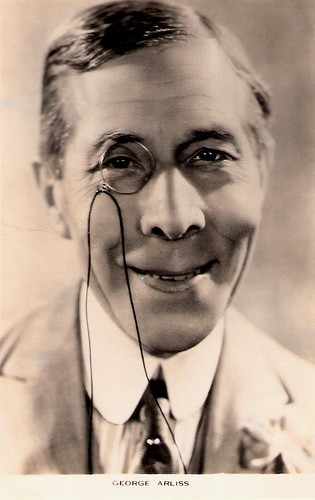
Vintage postcard.
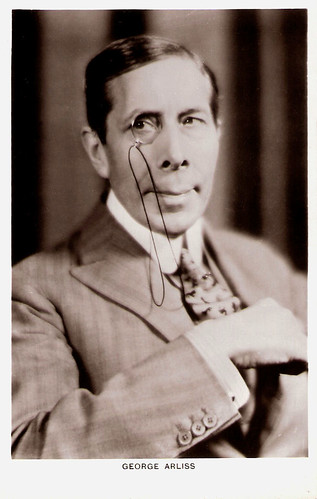
British postcard in the Picturegoer series, no. 473.
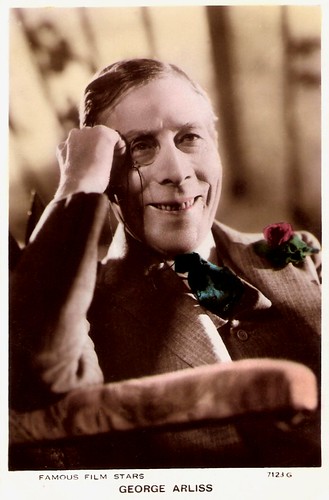
British postcard in the 'Famous Film Stars' series by Valentine, no. 7123G.
The Devil
George Arliss was born George Augustus Andrews in London, England, in 1868. He began his stage career in 1887 in the British provinces. By 1900, he was playing London's West End in supporting roles. He embarked for a tour of America in 1901 in Mrs. Patrick Campbell's troupe. Intending to remain in the USA only for the length of the tour, he stayed for twenty years eventually becoming a star on Broadway in 1908 with the satiric drama The Devil, by Ferenc Molnar. Producer George Tyler commissioned a play specifically tailored for Arliss in 1911 and the actor toured in Disraeli for five years, eventually becoming closely identified with the 19th century British prime minister. He began his film career with The Devil (1921, James Young), followed by Disraeli (1921, Henry Kolker), and four other silent films. Today, only The Devil and The Green Goddess (1923, Sidney Olcott), based on William Archer’s stage play, are known to have survived. He remade Disraeli (1929, Alfred E. Green) in sound and won the Academy Award for Best Actor. At 61, he converted successfully from a star of the legitimate theater, then of silent films, and finally into the talkies.
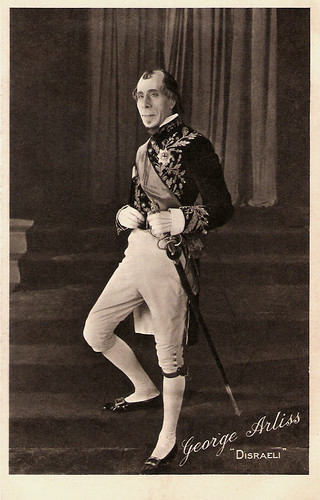
Vintage postcard. Photo: publicity still for Disraeli.
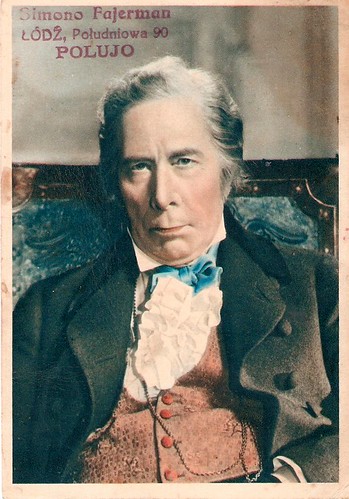
Polish postcard by De Reszke Minors Cigarettes. Photo: still from The House of Rothschild (1934, Alfred L. Werker).
Creative Control
George Arliss made ten sound films exclusively for Warner Bros. under a contract that gave the star an unusual amount of creative control over his films. Curiously, his casting of actors and rewriting of scripts were privileges granted him by the studio that are not even mentioned in his contract. After his first three films, Arliss approved an undistinguished director, John Adolfi, to direct each of his films from that point on. Adolfi soon found himself regarded as a successful director of the critically and financially acclaimed Arliss films. Arliss preferred to use the same reliable actors from film to film such as Ivan Simpson and Charles Evans. Yet he had an eye for discovering newcomers like James Cagney, Randolph Scott, and Dick Powell. The Man Who Played God (1932, John G. Adolfi) was Bette Davis' first leading role. Until the end of Davis' life, she would credit Arliss for personally insisting upon her as his leading lady and giving her a chance to show her mettle. The two also co-starred in The Working Man (1933, John G. Adolfi).
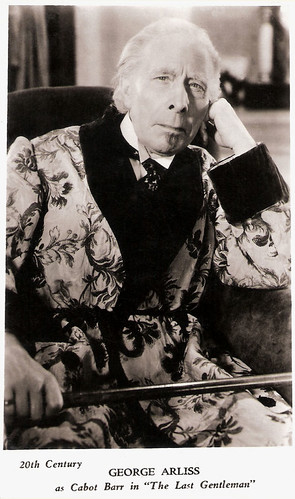
British card. Photo: 20th Century. Publicity still for The Last Gentleman (1934, Sidney Lanfield).
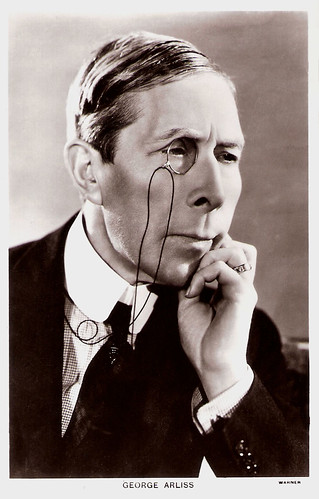
British postcard in the Picturegoer Series, London, no. 473a. Photo: Warner.

British postcard in the Picturegoer Series, London, no. 473b. Photo: Gainsborough.
A Stolen Star
Despite his extensive involvement in the planning and production of his films, George Arliss claimed credit only for acting. Working closely with Warners production chief, Darryl Zanuck, Arliss left the studio when Zanuck resigned in April 1933. Zanuck quickly signed him to make new films at Zanuck's fledgling studio, 20th Century Pictures, prompting Warners to bitterly complain to the Motion Picture Academy of Arts and Sciences that Zanuck had ‘stolen’ their star. Arliss is remembered primarily for his witty series of historical biographies such as Alexander Hamilton (1931, John G. Adolfi), Voltaire (1933, John G. Adolfi), The House of Rothschild (1934, Alfred L. Werker) and Cardinal Richelieu (1935, Rowland V. Lee). However, he had a second string to his bow, domestic comedies such as The Millionaire (1931, John G. Adolfi), A Successful Calamity (1932, John G. Adolfi) and The Last Gentleman (1934, Sidney Lanfield). In these films he often appeared with his wife, Florence Arliss. He was approaching 70 when he completed the British-made Doctor Syn (1937, Roy William Neill). He and Flo returned to America later that year to visit old friends. Returning to their home in London in 1939, the onset of World War II prevented their return to America. Braving the German aerial bombing of London throughout the war, George Arliss remained in his native city where he died in 1946.
Clips from The Man Who Played God (1932, John G. Adolfi) with George Arliss and Bette Davis. Source: Waco Agents (YouTube).
The final scene from The House of Rothschild (1934, Alfred L. Werker) with George Arliss and Loretta Young. This was one of the first live-action sequences to be made in three-color Technicolor. Source: Perfect Jazz (YouTube).
Sources: Wikipedia and IMDb.